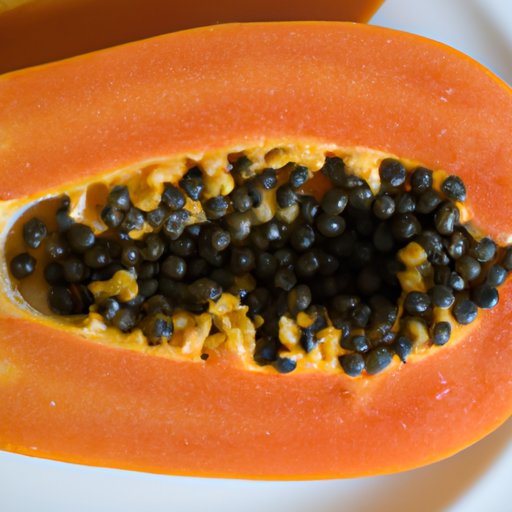
I. Introduction
Have you ever found yourself staring at a pile of papayas in the grocery store, trying to figure out which ones are ripe and which ones aren’t? It can be a frustrating experience, but fear not! This article is here to provide you with a definitive guide to determining the ripeness of a papaya. We’ll take you through the steps to check for ripeness, describe the different stages, offer some additional indicators, and even share some insights from professionals in the industry.
II. How to Check for Ripeness
The first step in determining if a papaya is ripe is to examine the color. Ripe papayas should have a yellow or orange hue, and there should be no green left on the skin. If there’s still green present, the papaya is not ripe yet.
Next, feel the texture of the skin. Ripe papayas should be somewhat soft to the touch, but not squishy. The skin should give slightly when you press down on it with your fingers.
Finally, press gently on the end of the papaya. If the fruit gives a little and feels slightly soft, it’s ripe. If it’s hard, it’s not ripe yet.

III. The Different Stages of Papaya Ripeness
Unripe papayas will be mostly green in color, with little to no yellow or orange present. The skin will be hard to the touch, and there won’t be any give when you press down on it.
Partially ripe papayas will have some yellow or orange coloring starting to appear, with patches of green still present. The skin will be slightly softer than an unripe papaya, but still relatively firm.
Fully ripe papayas will be mostly yellow or orange in color, with no green left on the skin. The skin will be soft to the touch, with a little bit of give when you press down on it.
IV. Additional Indicators of Papaya Ripeness
In addition to the color and feel of the papaya, there are a couple of other indicators of ripeness to keep in mind.
First, a ripe papaya should have a distinct aroma. If it smells somewhat sweet and tropical, it’s probably ripe. If it doesn’t have much of a smell, it’s likely not ripe yet.
Secondly, the texture of the flesh should also be taken into account. When you slice open a ripe papaya, the flesh should be somewhat soft and almost creamy. If it’s still hard and crunchy, it’s not ripe yet.
V. Recipes and Dishes that Pair Best with Ripe Papaya
Once you’ve determined that your papaya is ripe and ready to eat, it’s time to figure out what to do with it. Luckily, there are plenty of recipes and dishes that utilize ripe papayas!
One easy option is to cut the papaya in half, scoop out the seeds, and fill the cavity with yogurt and granola for a healthy breakfast or snack. You can also slice it up and add it to a fruit salad, or blend it up with some ice and other tropical fruits for a delicious smoothie.
VI. Insights from Professionals in the Industry
To get a better idea of how the pros determine whether a papaya is ripe, we reached out to a few chefs and farmers who work with papayas on a regular basis.
Chef Juan Pablo from a local restaurant told us that he typically uses a combination of the skin color, aroma, and texture when gauging ripeness. He also stressed the importance of using fully ripe papayas in his recipes to maximize flavor.
Farmer Maria from a local farm shared that she also relies heavily on skin color and texture when checking for ripeness. She added that it’s important to let the fruit ripen fully on the tree before harvesting.
VII. Comparing Techniques for Gauging the Ripeness of Different Types of Papaya
It’s worth noting that there are different varieties of papaya, such as Mexican, Hawaiian, and Caribbean. These different types may have slightly different ripening processes and indicators.
Mexican papayas, for instance, tend to have a greenish skin even when they’re fully ripe. The skin will feel soft to the touch, however, and the aroma will be sweet and musky.
Hawaiian papayas will start to turn yellow as they ripen, and the skin should be slightly soft to the touch. The aroma will be similar to that of a Mexican papaya.
Caribbean papayas will turn mostly yellow when they’re ripe, with some green still present. The flesh will be softer than a Mexican or Hawaiian papaya, almost giving the impression that it’s overripe.
VIII. Personal Anecdotes to Illustrate the Importance of Selecting a Fully Ripened Papaya
As a personal anecdote, I once attempted to make a papaya smoothie with an unripe papaya because it was all that was available at the store. Needless to say, it was not a pleasant experience! The smoothie was sour and had an unpleasant aftertaste. Since then, I’ve made sure to only buy fully ripe papayas.
IX. Conclusion
Determining whether a papaya is ripe doesn’t have to be a frustrating experience. By following the steps outlined in this article, you should be able to confidently select a fully ripened papaya for all of your culinary needs.





